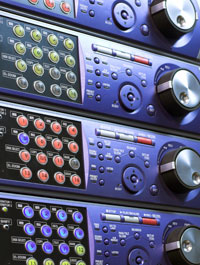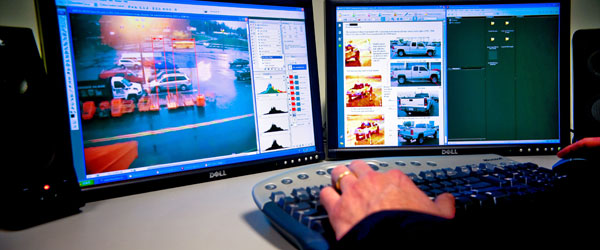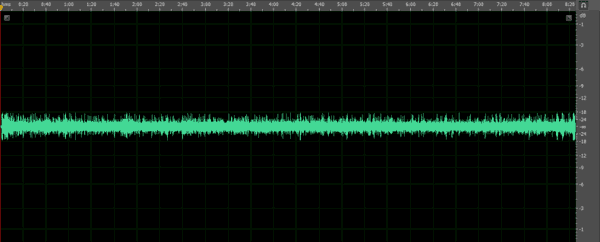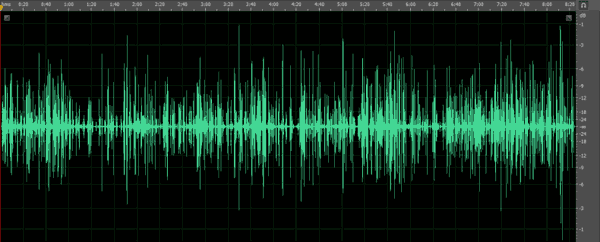How It’s Done
Audio and Video Evidence That May Be Analyzed
Audio and video evidence can be found at more locations and from more diverse sources than ever before. From convenience stores to fast food restaurants, malls to banks, traffic intersections to parks, CCTV systems are virtually everywhere. And cell phone cameras extend a watchful eye to nearly every corner of every town. Audio evidence may be available from 911 calls, telephone answering machines, voicemail recordings, video cameras, cell phones and computer files.
How the Evidence Is Collected
 Depending on the circumstance, the surroundings, and the witnesses who may have been present, several different recordings of an event may be available. The responding officers or crime scene investigators should first identify all video or audio evidence that may exist. In addition to surveillance cameras at the scene, surveillance systems nearby may provide valuable footage, such as recordings of a perpetrator approaching or fleeing a scene.
Depending on the circumstance, the surroundings, and the witnesses who may have been present, several different recordings of an event may be available. The responding officers or crime scene investigators should first identify all video or audio evidence that may exist. In addition to surveillance cameras at the scene, surveillance systems nearby may provide valuable footage, such as recordings of a perpetrator approaching or fleeing a scene.
Even if the recording does not appear to be very clear or useful, all relevant footage should be collected. Forensic enhancement may recover details that aren’t noticeable when viewing or listening to the unprocessed recording.
Digital video and audio - Well over half of all closed-circuit television evidence seized by police today is digital and file-based, although some systems can record to digital magnetic tape. Digital video recorders come in two general types: embedded stand-alone and PC-based. Both types generally record the audio and video to hard drives; however, some systems record to secure digital (SD) cards and other removable media.
Digital video and audio evidence from CCTV systems are generally proprietary in nature and require a special software player produced by the manufacturer to play back the collected recordings properly. When the video and audio is collected from the device it needs to be retrieved in a manner that produces the best quality possible, which is usually the proprietary recorded files. There are numerous types of digital video and audio recording devices, with a variety of methods of exporting these files. Some will have CD/DVD writing capabilities, some use USB for output, and some, although digital, may only have analog outputs. Find further information on proper collection methods ▸
Analog video and audio - Analog video systems are rapidly becoming a recording technology of the past; however, many are still in use today. If a system uses analog tape, the investigator should bear in mind that every playback of the tape will degrade the recorded images. Prior to ejecting the tape, the investigator will make sure the tape is stopped, document everything on the display, then eject the tape and remove the write protection tab to prevent it from being recorded over. A copy of the tape should then be made for all future viewing, preserving the original video evidence.
Regardless of whether the evidence was recorded by a digital or analog system, the investigator should note the make and model of the recording device and important details about the recording system (e.g., how many cameras are connected and recording, whether it is recording in time-lapse mode, the current time/date, and the time/date on the recorder’s display). It is also preferable to sketch the cameras’ positions.
Who Conducts the Analysis
The disciplines of forensic audio analysis, forensic video analysis, image analysis and computer forensics are recognized as four separate disciplines by the American Society of Crime Laboratory Directors Laboratory Accreditation Board (ASCLD/LAB). Many Federal, State and local law enforcement and private agencies are now developing Digital and Multi-Media Sections within their agencies that may include some or all of these disciplines. In some agencies, examinations may be conducted by the same person. In large agencies, and on the Federal and State level, most examiners specialize in one discipline and become a subject matter expert after years of experience.
Agencies may have an in-house training program that includes vendor-based training, training with senior examiners and competency testing. This ensures analysts have the specific skills to match the services their agency provides. Additional information on training requirements is available from guidelines of the Scientific Working Groups on Digital Evidence and Imaging Technology.
Two certification programs currently exist in the discipline of Video Analysis: Law Enforcement and Emergency Services Video Association (LEVA) and the International Association for Identification (IAI). In the field of forensic audio, training courses are available, but no specific certification currently exists.

Courtesy of Target® Forensic Services
How the Analysis Is Performed
The first step of an analysis is for the examiner to simply listen to or view the recorded footage. The examiner will then begin to locate the area of interest to be enhanced and examined in closer detail using specialized devices and software.
Before processing audio and video evidence, a working copy of the evidence may be created. This assures that the original evidence is always available in its unaltered state. In addition, the original will always be available for comparison to the processed copy.
All examination procedures are carefully constructed so that the image or video is a true and accurate representation of the scene. Investigators never change the recorded data—they only enhance what is already present.
Video Enhancement Techniques - A variety of enhancement techniques can be employed on video evidence. It is important that the best video recording be submitted to obtain the best enhancement results. Limitations on the enhancement process may exist if an analog copy or digital file that has undergone additional compression is submitted for analysis. Techniques can include:
Sharpening – Makes edges of images in the recording become more clear and distinct.
Video stabilization – Reduces the amount of movement in the video, producing the smoothest possible playback.
Masking – Covers the face or areas of the video that may protect a witness, victim or law enforcement officer.
Interlacing – In an analog system, interlaced scanning is used to record images (a technique of combining two television fields in order to produce a full frame of video). A process called de-interlacing may be used to retrieve the information in both fields of video.
Demultiplexing – Allows for isolation of each camera. In CCTV systems, a device called a multiplexer is used to combine multiple video signals into a single signal or separate a combined signal. These devices are frequently used in security and law enforcement applications for recording and/or displaying multiple camera images simultaneously or in succession.
Audio Enhancement Techniques - For audio recordings, a variety of filters can be applied to enhance the material, bringing out specific aspects or events contained in the recording.
Frequency Equalization − Highly precise equalizers can be used to boost or cut specific bands of frequencies. To help make speech more intelligible, the frequency band containing most speech content, 200Hz–5000Hz, can be amplified or isolated. If amplification is applied to a frequency range, other information residing in this frequency range will be boosted as well. If noise resides in this same range, this noise will also be increased, limiting the ability to clarify voices.
Loud background noises may be analyzed by a spectrum analyzer and the corresponding frequencies reduced so that these noises are less noticeable.
Compression − Faint sounds in the recording can be boosted by compressing or leveling the signal so that the dynamic range of the material is reduced, making soft sounds more apparent.

Waveform of a recording made at a low volume with significantly loud ambient noise that is masking the speech content of the recording.

The same recording after enhancement. The noise is attenuated and the volume of the speech is increased.